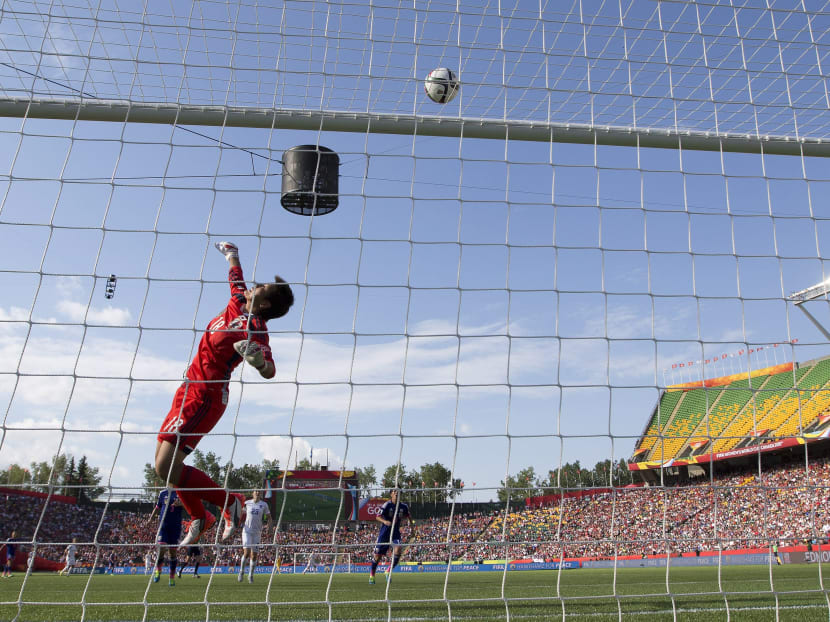World Cup field puts haves and have-nots on display
VANCOUVER (British Columbia) — One of the benefits of an expanded field of 24 teams at the Women’s World Cup this year was that there were lots of fresh faces playing in Canada, teams like Ivory Coast, Ecuador and Cameroon.

Japan goalkeeper Ayumi Kaihori (18) makes a save against England during the second half of a semifinal in the FIFA Women's World Cup soccer tournament, Wednesday, July 1, 2015, in Edmonton, Alberta, Canada. Photo: AP
VANCOUVER (British Columbia) — One of the benefits of an expanded field of 24 teams at the Women’s World Cup this year was that there were lots of fresh faces playing in Canada, teams like Ivory Coast, Ecuador and Cameroon.
While that was good for the women’s game globally, the expansion showed the stark contrast between the haves and have-nots. Case in point was Ivory Coast, which arrived in Canada and 72 hours later opened the tournament with a 10-0 loss to top-ranked Germany.
Ivory Coast went on to lose to Thailand and Norway before exiting the tournament. Afterward, coach Clementine Toure made an impassioned plea.
“I want to make an appeal to not only our federation, but to all of Africa, that women’s football has arrived. We believe in our women. We have a good team,” she said through a translator following the team’s final group match. “The Ivory Coast showed it deserves a place in the World Cup. But we also deserved to be better prepared. We didn’t deserve to be humiliated.”
The month-long tournament has been played across six Canadian cities. It concludes this weekend with the third-place match between Germany and England tomorrow (July 4) in Edmonton, and the title game between the United States and Japan on Sunday at Vancouver’s BC Place.
The global attention on the World Cup could give national federations incentive to invest more in the women’s game. There is evidence it’s already happening, said Tatjana Haenni, FIFA’s head of women’s football.
“We know that Thailand really tried to prepare for the tournament the best they could. They put a really good program in place, they travelled to Europe to play some games, they organised a camp, and they got some consultants to help the team and the staff to reach their best performance possible,” she said.
While some lopsided results were expected, Haenni said bringing more teams in will help the game as a whole.
“That these teams realised what the level of play is at a FIFA World Cup, and that there is a gap between the top teams and where they are, they need to make sure they have better leagues, better player development, better national team plans with more games and programs in place to close that gap,” she told The Associated Press.
While FIFA has been criticised at times for its treatment of the women’s game in general — from President Sepp Blatter’s infamous suggestion in 2004 that the women could wear tighter shorts, to the cries of gender discrimination over the artificial turf surface at this year’s tournament — soccer’s international governing body has taken positive steps over the last decade to grow the sport.
There were 12 teams in the first Women’s World Cup in 1991, expanding to 16 in 1999 before jumping to 24 this year. FIFA added an under-20 Women’s World Cup in 2002, and an under-17 tournament in 2008.
Since 2004, FIFA has decreed that a percentage of its Financial Assistance Program funds it provides to member nations go to development on the women’s side. FIFA says the 15 per cent mandate is a starting point and many member nations invest far more, with the average at 22 per cent in 2014. Member nations can also secure additional funds through the international governing body’s numerous development programs.
Last year, the FIFA Congress adopted a comprehensive list of principles for developing the women’s game. During this year’s tournament, the organisation announced programs to develop women for leadership positions, as well as a scholarship program to train female coaches.
“We feel there’s a huge momentum now for women’s football, and women in football,” Haenni said. “I think the world is open to embrace the sport. We have already seen tremendous success from a television viewership point of view, to social media and overall media coverage.”
Still, work remains. An example of the lack of support at the local level was evident last year at the regional Confederation of North, Central American and Caribbean Association Football (CONCACAF) championship, a tournament which served as qualifying for the World Cup.
Trinidad and Tobago’s national team arrived in US for the event with just US$500 (S$673.9) collectively and no equipment. Volunteer coach Randy Waldrum, also coach of the National Women’s Soccer League’s (NWSL) Houston Dash, sent out an urgent plea for help via Twitter. Money came pouring in.
Already Cameroon is benefiting in one way from the exposure that nation received at the World Cup.
Ranked No 53 in the world, Cameroon made its World Cup debut in Canada and pushed through to the round of 16. While the federation support may not be there, coach Enow Ngachu said there’s increased interest — a direct result of the team’s success.
“We have the talented players. The problem African nations face is preparation,” he said, adding that he’s hopeful: “The day we are prepared well an African nation will be able to win the World Cup.” AP





